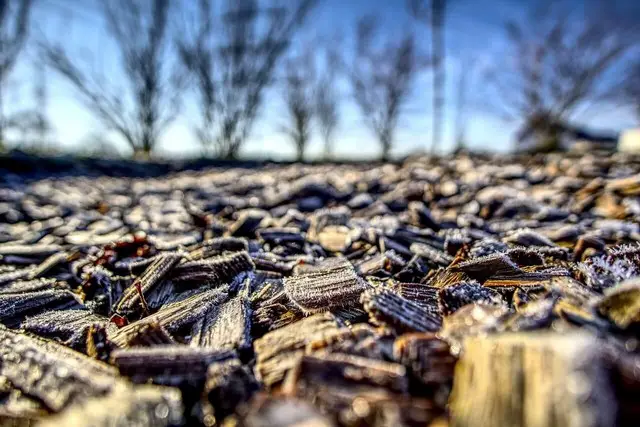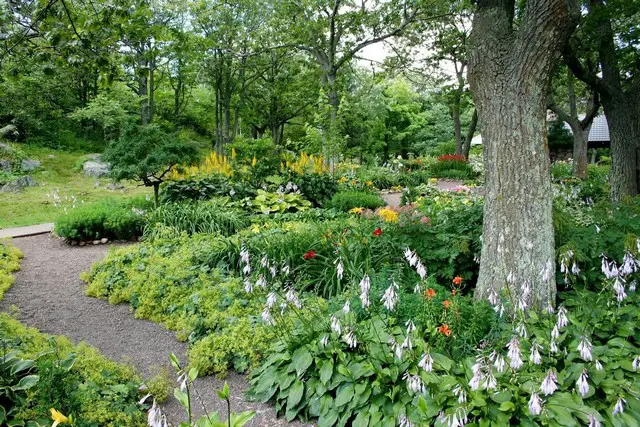Last Updated on January 16, 2023 by Grow with Bovees
Trees are beautiful natural features and can be made the focal point of any garden, particularly with a bit of imagination regarding ideas about landscaping around trees.
However, when the roots of a tree become exposed, it becomes a tripping hazard and can make your lawn look unkempt. Additionally, trees can become vulnerable when roots are exposed, and if left unprotected, it can be fatal.
The landscaping ideas we discuss will help you protect the roots of your tree while making it aesthetically pleasing.
In this article, we answer the following questions:
- Why Are My Tree’s Roots Exposed?
- What Can I Put Around a Tree With Exposed Roots?
- What Can I Use to Cover Exposed Tree Roots?
- What Should I Avoid When Covering Tree Roots?
Why Are My Tree’s Roots Exposed?
There are five kinds of tree roots; taproots absorb nutrients and water, while others help stabilize the tree. Tree roots usually grow below the ground. However, occasionally roots are forced above the surface by lack of space, wind or rain erosion, or soil wearing from foot traffic.
Some trees, such as willows, poplars, and certain types of maple, have feeder roots that grow close to the surface. It’s also common for older trees to have exposed roots. However, this tends to happen if the top layer of soil is too thin.
Exposed tree roots can easily be damaged by mowers, trimmers, and people walking over them. Any wounds caused to the roots leave your tree vulnerable to infection and rot.

What Can I Put Around a Tree With Exposed Roots?
Edging can add a clean, finished look to any landscaping you carry out in your garden. Root barriers may also need to be installed to prevent any damage to your yard.
Edging

There are different types of edging materials you can use in your outdoor space; some are easier to install than others. If you require a border that’s practical and easy to maintain, plastic or concrete edging could be ideal. However, if you want to achieve a more natural look, you could use wood or cut a border into the ground.
Natural edge: This is the most economical way to create an edging barrier for your mulch. The idea is that by digging a trench around your tree, and using an edger, you can prevent the mulch from spilling onto your lawn. However, occasionally, mulch may overflow due to rain or wind, making it messier than other border types.
Concrete blocks: These come in many shapes, sizes, and colors. They can add some fantastic textures to your garden, and they’re easy to install.
Concrete edging can be costly, but they’re more durable than other borders and won’t attract pests. They can also be re-arranged if you decide to change the aesthetics of your garden.
Plastic edging: This type of edging is versatile and usually comes with stakes that allow you to pin it into the ground. Other plastic borders have a jagged edge that enables you to push it straight into the soil.
Wood borders: Materials such as driftwood give a natural feel, or for a more uniform look, you can use something like a two-by-four. You could also purchase log rolls which are purposely made for edging. These have intermittent stakes along the bottom side so you can push them into the ground.
Wood borders will require more maintenance than plastic or concrete edging and could attract pests.
Root Barriers
If the tree roots are growing too close to your property, you may want to consider installing root barriers. Root barriers are placed below the surface around the tree’s roots to prevent growth.
If the tree roots are too close or already invading your yard, they may need pruning before the barrier is installed. It’s best to get a professional arborist to prune or remove exposed tree roots. Pruning is a delicate process that can be fatal for your tree if it’s done incorrectly.
What Can I Use to Cover Exposed Tree Roots?
You could use several materials to cover your tree’s roots, including mulch, plants, or decking.
Mulch With Rocks or Organic Mulch

Mulching is the easiest way to cover tree roots. Mulch helps suppress weeds and lock moisture into the soil. It also acts as a wind barrier and protects your tree roots from direct sunlight.
There are two types of mulch; inorganic and organic. Each has advantages and disadvantages, but you can use either around your tree.
Inorganic Mulch

Inorganic mulches include rocks and gravel, but some varieties contain rubber and plastic. These types of mulch don’t attract pests, which makes them low-maintenance. They can be made a permanent part of your landscape, and they’re incredible at suppressing weeds.
However, rubber and plastic-based mulches can degrade and pollute your garden. A rock-based mulch can also compact and heat the soil in warmer weather which can be bad for your tree.
Many inorganic mulches can also block nutrients from reaching the soil. Although, materials such as decomposed granite add nutrients as it decomposes.
Some examples of types of landscaping stone that can be used as inorganic mulches are:
- Decomposed granite.
- Pea Gravel.
- Crushed stone.
- River rocks.
- Limestone gravel.
- Lava rocks.
- Pebbles.
Organic Mulch

Organic mulches are more affordable than inorganic mulches. They’re made up of natural materials and contain nutrients that act as slow-release plant food. As worms break down the mulch, it’ll improve the soil structure in the area beneath, helping it to retain moisture. It’ll also make the soil more fertile and free-draining.
However, organic mulch needs replenishing when you see signs of decomposition. So, in the grand scheme of things, it can end up being more costly. Saying this, you can always make your own by using materials like leaves.
The main disadvantage of organic mulch is that it can attract pests such as termites, which may damage your tree.
Organic mulches are usually made from dead plant materials such as:
- Leaves.
- Wood chips.
- Straw.
- Bark.
- Grass clippings.
Plants

Some plants will thrive in the cool, shady area that lies beneath the foliage of your stunning tree. You could create a masterpiece that will eventually cover the tree’s base by planting in between the roots.
Choosing Plants
Use baby plants when creating your flower bed. These will require less digging, and you’re less likely to disturb or damage the roots. It’s also a good idea to use perennials as these won’t need replacing annually.
Always plan out where you’re going to plant flowers when your tree canopy is full of foliage. This way, you can see where the full or partial shade areas are, which will help you decide where to put certain plants.
Taller flowers and shrubs always look best, closer to the tree’s base, near the trunk and low-lying plants near the border.
There are many plants that you could use as a ground cover. Brunnera, coral bells, common wild ginger, and heartleaf foamflower look incredible around a tree base.

Other plants, such as wild strawberries, can also be used. They love the partial shade, and they’ll reward you with fruit.
You could put mulch down around the plants once they’ve been planted. Alternatively, you may want to use potted plants and place them on top of a mulch bed.
Decking
Decking is a great way to incorporate a tree into your outdoor living space. Building a raised deck around the tree will protect it from foot traffic, soil compaction, trimmers and mowers.
Make sure there is ample enough space around the tree’s trunk to allow for growth. Gaps between the decking planks will still allow water and oxygen through. Leaves should also be able to get through, which will provide the soil with the nutrients the tree needs.
What Should I Avoid When Covering Tree Roots?

Landscape Fabric
You may have heard that you can place landscaping fabric underneath the mulch to prevent weeds from growing. However, landscape fabric can block the roots from accessing the nutrients provided by mulching. Some mulches will help suppress weed growth without the need to line with fabric.
Over-Mulching
The mulch should only just cover the tree roots, don’t pile mulch against the tree trunk. Over-mulching can cause roots to grow up and around the tree trunk, killing the tree; this is called root girdling.
Take a look at this video which shows you how to use mulch correctly.
Over-Soiling
Don’t add soil over the tree roots. Soil often contains clay and sand. By placing just 4-inches of soil over the roots, air and water pockets reduce in size.
When taproots cannot find the same level of oxygen and water as before, they may begin to die away. This can cause considerable stress to your tree, which can attract pests or lead to disease.
Final Thoughts

Before covering the roots with the first thing that springs to mind, consider the health of your tree. Leaving exposed tree roots can be fatal, but covering them with the wrong material can harm the tree.
It’s a good idea to contact an arborist to check your tree’s health and put down root barriers if needed before you begin landscaping.
After considering your tree’s health, what you use for landscaping around trees depends on how you want your garden to look. How much time you’re able to spend maintaining your yard may also determine your choice.
References:

